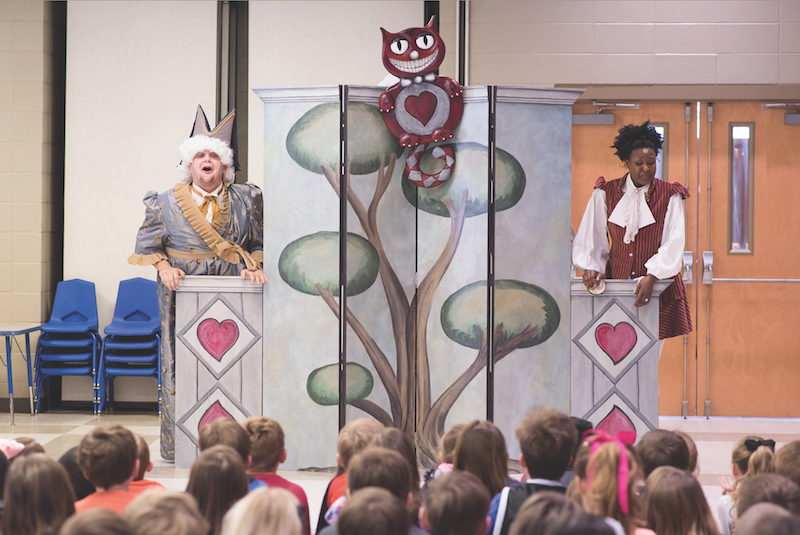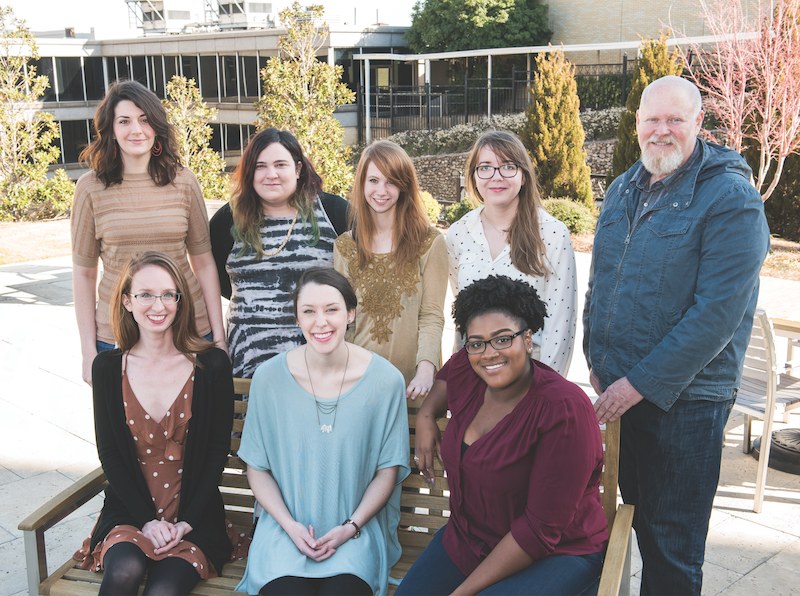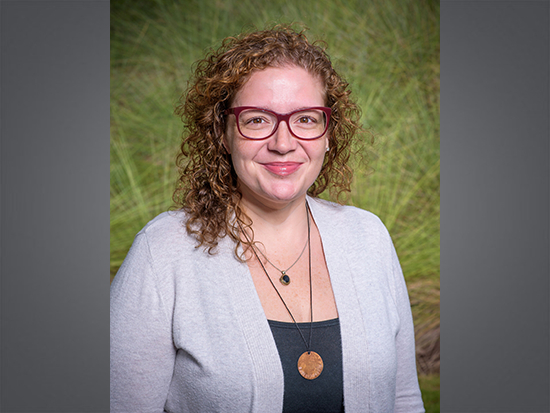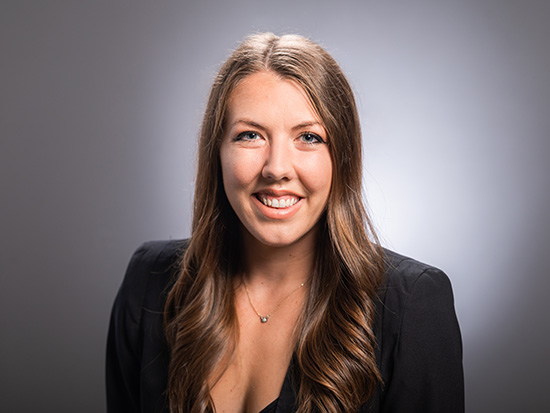Every day, our faculty and students are using their talents to transform the community.
By Laurel Mills
Photos by Nik Layman and courtesy of the Departments of Art and Art History, Music and Theatre

Partnerships between students and community stakeholders create unique opportunities for both.
There is no shortage of invested professors in the College of Arts and Sciences, and they are creating incredible opportunities for their undergraduate and graduate students to engage with the community in ways that enrich both students and community partners.
The UAB Departments of Theatre, Art and Art History and Music are just a few areas creating learning experiences for students that go far beyond the classroom.
And the community is benefiting as well.
Students gain thoughtful, real-world experience. Organizations make use of one of the city’s finest resources. It’s something we can all celebrate.
On The Road
UAB Department of Theatre—Touring Companies
Thirty-three years ago, UAB Touring Company began with a Shakespeare Ensemble. Faculty Member Rick Plummer hoped to “bring the Bard’s words to life,” and he did just that with an engaging program embraced by area high schools. Today, Theatre UAB Touring Companies include five groups: the aforementioned UAB Shakespeare Company, UAB Cabaret, UAB Kids on the Block, UAB Tolerance Project and UAB Presents Alice in Wonderland.From an anti-bullying program aimed at children in kindergarten through fourth grade (UAB Kids on the Block) to a condensed version of “A Midsummer Night’s Dream” (Shakespeare) and an hour-long program of favorites from movies like “Frozen” (UAB Cabaret), Theatre UAB Touring Companies booked 77 shows for the 2015-2016 season and expect to perform for nearly 17,000 students. The program casts sophomores, juniors, and seniors and quickly throws them into the real-life arena of planning and executing a successful touring show. “We try to do things that are curriculum-based or something that we think they will be reading in the future at their schools,” says Melissa “Mel” Christian, Program Manager and Tour Coordinator for the UAB Department of Theatre.
 UAB Theatre students in the Alice in Wonderland Touring Company perform for children at Southminster Day School in Birmingham. Christian sees a definite benefit to students that participate. “The main thing is they learn how to deal with professional situations,” she says. “They learn how to problem solve, and they really learn how to work as an ensemble.”
UAB Theatre students in the Alice in Wonderland Touring Company perform for children at Southminster Day School in Birmingham. Christian sees a definite benefit to students that participate. “The main thing is they learn how to deal with professional situations,” she says. “They learn how to problem solve, and they really learn how to work as an ensemble.”The experience that students gain translates far beyond the stage. “It helps when they are just out of school and going on interviews. They have to present themselves as grown-ups, not students,” Christian says. “It’s one of the best training grounds they can get within the department.”
For many UAB students, the touring company boosts their confidence in a way that traditional classroom experience does not. “Once they get two tours under their belt, they realize this is something they can do: I’m actually out there doing a real job in the realm that I love,” she says. “I like to watch how that progresses throughout the year and how their confidence grows.”
For participating schools, UAB Touring Companies provide affordable theater options to those in Birmingham and surrounding areas like Dallas and Walker counties. “In Jefferson County, we can bring a show to a school for $150,” Christian says. “Our highest cost is $250 plus $.57/mile. We can travel as far out as we can to get them back here by 5:30 p.m.”
For many students in less urban areas, theater is a very special treat, and the students in the audience are learning as much as the performers. “For the counties that are more outlying, I’ve been told several times that this is one of the few arts events that they get for the year,” Christian says. “We like to think that we’re getting young people excited about the arts. We think it’s a good representation of UAB Theatre and what theater and the arts can offer.”
“They learn how to deal with professional situations. They learn how to problem solve, and they really learn how to work as an ensemble.”
Mel Christian, Program Manager and Tour Coordinator
What UAB students take from their time with the touring companies speaks to the true power of experiential learning and the importance of creating such unique opportunities. “When I was in school, you tried to be invisible and turn in your work and get the grades,” Christian says. “And there’s so much more you can get out of college.”
Hitting the High Notes
UAB Department of Music—Honor Bands and Honor Choir
UAB Honor Bands operates two programs—one in December and one in the summer—that allow high school students to practice and perform with current UAB students. The December Honor Band brings 400 middle school and 400 high school students to campus. After auditioning for faculty, students are placed into five different groups and then perform a concert in the Alys Stephens Center for an audience of nearly 1,500. In the summer, students have a week-long experience that culminates in a concert as well.“The band directors in the community talk about it as being the best honor band experience for their students in the state,” says Rhonda “Sue” Samuels, Director of Bands. “The purpose of the events are to give those middle school and high school students a very strong musical experience in a compressed amount of time and to give them a positive experience on UAB campus. We also give them a strong experience to take back to their school.”

Participating students aren’t only exposed to accomplished college students, but visiting clinicians and guest conductors as well. “Most are nationally known music education figures,” Samuels says.
“The students learn a lot from the invited guests. It’s a great way to collaborate and see what other people are doing in the region.”
Brian Kittredge, Assistant Professor of Music and Director of Choral Activities
 Department of Music Chair Patrick Evans welcomes the crowd. Getting to practice and perform with talented music students from all over is a great asset to Honor Band participants. “They get to perform with students of similar interest and abilities from other schools, and they meet new people who are like-minded and similarly talented,” Samuels says. “They learn to develop a sense of excellence and hard work in a short amount of time.”
Department of Music Chair Patrick Evans welcomes the crowd. Getting to practice and perform with talented music students from all over is a great asset to Honor Band participants. “They get to perform with students of similar interest and abilities from other schools, and they meet new people who are like-minded and similarly talented,” Samuels says. “They learn to develop a sense of excellence and hard work in a short amount of time.”Samuels is always happy to see how the Honor Bands strengthen UAB’s ties to the community. “It broadens our UAB community to involve those participants and their families,” she says. “It lets the community know that we have a lot to offer in terms of instruction and facilities and a desire to help area schools with their band programs.”
Many UAB Honor Band participants end up as students of UAB, but regardless of whether or not Honor Band members decide to become a Blazer, Samuels is glad they have this unique experience. “You watch kids grow up,” Samuels says. “It’s very similar to an all-star in baseball or all-state in sports. It becomes truly an honor and something they look forward to each year.”
The UAB Honor Choir is similar in that it also allows current UAB students to perform with over 200 high school students and brings a guest clinician, artist, or composer to campus. Students can attend Honor Choir as young as sixth or seventh grade, and as late as 12th grade.
 Honor Band members practice before their performance. For Brian Kittredge, Assistant Professor of Music and Director of Choral Activities, UAB Honor Choir is a special experience. “It is a great way to share in community choral singing,” he says. “The students learn a lot from the invited guests, and of course they get a chance to work on campus at UAB. Our current music education students benefit from that because they get to see how other programs work.”
Honor Band members practice before their performance. For Brian Kittredge, Assistant Professor of Music and Director of Choral Activities, UAB Honor Choir is a special experience. “It is a great way to share in community choral singing,” he says. “The students learn a lot from the invited guests, and of course they get a chance to work on campus at UAB. Our current music education students benefit from that because they get to see how other programs work.”Honor Choir also builds community. “It is a great way to collaborate and see what other people are doing in the region,” Kittredge says.
At the end of the day, what’s most special about UAB’s music program is something that you won’t find on every campus. “In the concert choir, the top UAB ensemble, we have 23 different majors represented over a pool of 65 students,” Kittredge says. “Our concert choir comes from a wide variety of different interests on campus but with the common interest of making music. Students discover that you can study something else and still be involved in the arts, which is something that you can’t do at every institution.”
Design For Good
UAB Department of Art and Art History—Bloom Studio
Associate Professor of Art and Art History Doug Barrett knows good design, and he’s well versed in the process that creates it. “It’s kind of become this thing in graphic design—design thinking,” he says. “It’s the way that graphic designers solve problems when they’re trying to design a logo. You can use design thinking to do other things. You can use this to solve problems in the community.” Bloom UAB students – Front row: Kylee Williams, Anna-Kate Marcum, Keiah Flowers; Back Row: Kristen Martin, Lauren Hillgartner, Tori Absher, Marlena Roberts, Doug Barrett: Not Pictured: Wesley Coffman, Brandon Berry, Hannah Rettig. Through Bloom Studio, a student-run graphic design studio, Barrett does just that—using design to help the community. Each semester, three or four students are chosen by application to participate in Bloom Studio. Then, through long-term, research-driven projects with community partners like Alabama Regional Medical Services, Village Creek Society and the Cahaba River Society, students help nonprofit and underserved entities tell their story through design, and they create artifacts to that end, whether it’s a brochure or an informational poster.
Bloom UAB students – Front row: Kylee Williams, Anna-Kate Marcum, Keiah Flowers; Back Row: Kristen Martin, Lauren Hillgartner, Tori Absher, Marlena Roberts, Doug Barrett: Not Pictured: Wesley Coffman, Brandon Berry, Hannah Rettig. Through Bloom Studio, a student-run graphic design studio, Barrett does just that—using design to help the community. Each semester, three or four students are chosen by application to participate in Bloom Studio. Then, through long-term, research-driven projects with community partners like Alabama Regional Medical Services, Village Creek Society and the Cahaba River Society, students help nonprofit and underserved entities tell their story through design, and they create artifacts to that end, whether it’s a brochure or an informational poster. For community stakeholders, the benefits of working with students can be enormous. “A lot of small community organizations don’t know what they need, but they know something is missing,” Barrett says. “Something like Village Creek Society ends up with a logo and a brand, and they understand that there are steps they can take to tell their story better.”
Another current project involves the Southern Research Institute (SRI) and their breezeway dating back to the 1950s that doubles as a cafeteria. SRI would like to transform the space into more than a dining area. The idea is to create a place where people from different disciplines can come together and come up with new ideas that go beyond the boundaries of their individual areas of expertise. Bloom Studio students are working to make that change possible. “Students came up with five different visions for how to change cafeteria interior and how they can change the outside of the building,” Barrett says. “SRI starts the see the space differently and starts to see that there’s loads of potential. It’s not just redecorating—it’s creating a whole new space.”
Students participating in Bloom Studio gain valuable real-life experience from their work in the program that easily translates to their professional lives. “It’s kind of like a real client, and there is a real project and deadlines,” Barrett says. “If you don’t make the deadlines, you disappoint the client. In the end, it matters that you do that.”
But the benefit to students goes far beyond gaining exposure to clients. “The students start to understand that they can affect change,” Barrett says. “They can be a change agent to try and get stuff to happen around them. They get out of their comfort zone.”
Like so many of these programs that engage with the community, Barrett sees the students in Bloom Studio grow in a way that they would not from work done solely in the classroom. “It builds confidence in yourself,” he says. “It builds confidence in your design work. It elevates their design to the next step.”
Students aren’t the only ones learning through Bloom Studio—Barrett finds himself growing each semester, too. “I’m 53 years old, and I worked in advertising for many years,” he says. “You basically start producing work that is the exact same work you’ve always produced. When you work with students, it completely changes your idea of what design can be.”
“It’s like a real client, and there is a real project and deadlines. The students start to understand that they can affect change. They get out of their comfort zone.”
Doug Barrett, Associate Professor





